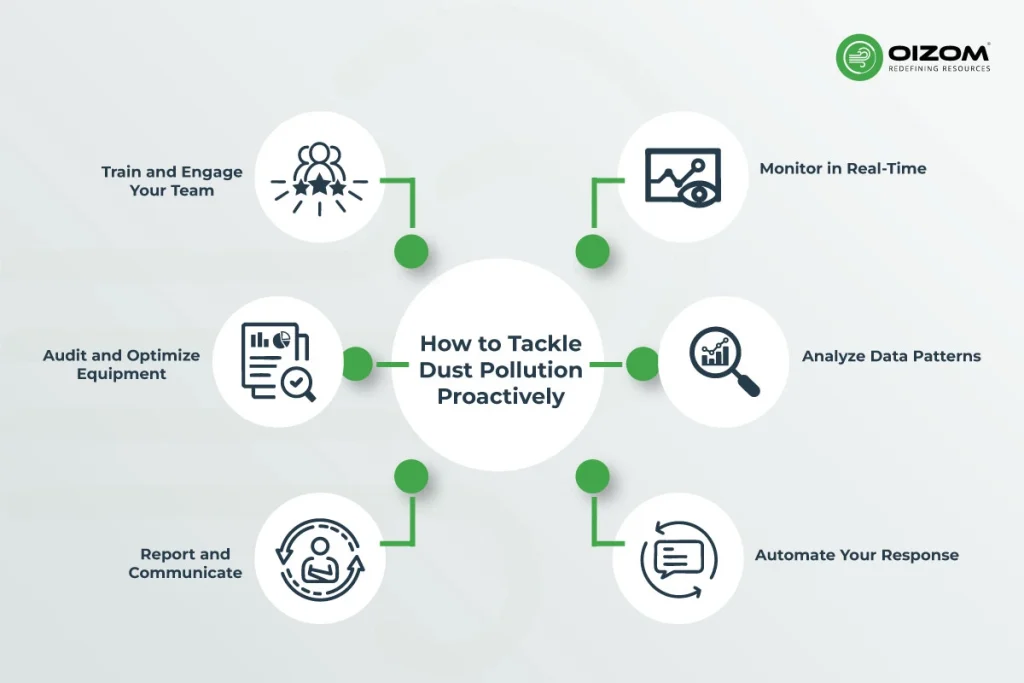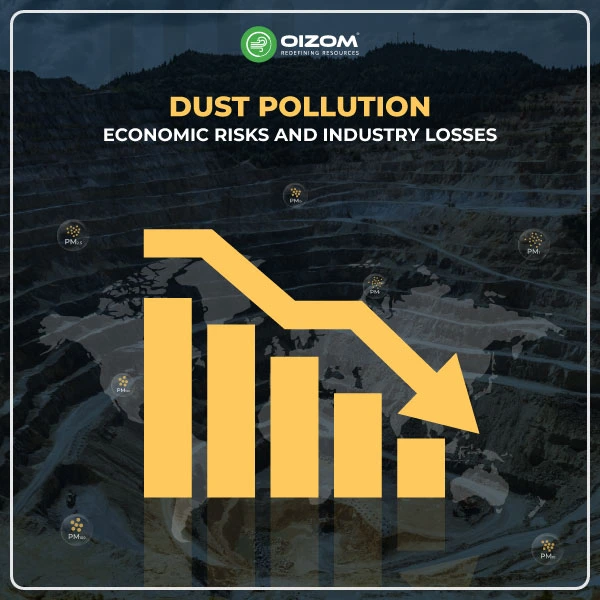TL: DR
Think dust is just a nuisance? Think again. Across industries, mining, construction, pharma, agriculture, transport, and even clean energy, dust is quietly draining profits. It clogs machines, ruins crops, reduces solar panel efficiency, and triggers health issues, driving up maintenance and healthcare costs. Fine particles like PM2.5 and PM10 are the worst offenders, sneaking into lungs, cleanrooms, and infrastructure, causing long-term damage.
From a 5–10% hit in productivity to increased hospital visits and equipment failures, dust contamination is a costly affair. But there’s a fix: smart, real-time monitoring systems like Dustroid that work even in humid or extreme environments. Add in data-driven dust suppression, green infrastructure, and stronger regulations, and you’ve got a strategy that actually works.
Bottom line? Tackling dust isn’t just about cleaner air. It’s about protecting people, profits, and the planet. Don’t wait for breakdowns; act on dust before it acts on you.
Dust Pollution: Economic Risks and Industry Losses
Have you ever thought about how much dust is actually costing your business? It’s easy to overlook, but dust pollution can quietly drain your resources, damaging equipment, affecting product quality, and leading to unexpected downtime.
In industries like manufacturing, mining, construction, or even pharma, dust isn’t just a nuisance. It’s a serious economic risk. When fine particles get into machines or cleanrooms, the result is often costly repairs, reduced efficiency, or non-compliance with safety standards. And let’s not forget the hidden costs: health risks for workers, lower productivity, and increased maintenance.
A study by the World Bank found that dust-related inefficiencies in industrial sectors can lead to productivity losses of up to 5–10% annually, just from equipment wear and process disruption alone. That’s a massive chunk off the bottom line.
This blog dives into the real impact of dust on your bottom line. We’ll explore how dust contamination leads to financial losses and, more importantly, what you can do to prevent it. If you’re managing operations, handling EHS responsibilities, or simply want to cut down on avoidable expenses, this is a must-read.
What is Dust Contamination?
Dust particles are tiny solid pieces that mix into the air from both natural events like volcanoes, dust storms, and sea sprays and human activities like mining, blasting, drilling, and construction. For this blog, we’re mainly talking about harmful dust from mining, quarrying, and road construction.
Common examples include rock dust, coal dust, fine powder from materials, and crystalline silica, all of which can pose serious health risks. When these dust particles are small enough to be breathed in, especially PM10 and PM2.5, they can travel deep into the lungs and cause long-term damage.
Particles around 100 microns can be inhaled but are often cleared out by the body’s natural defenses. The real concern lies with particles smaller than 10 microns (PM10), especially those smaller than 2.5 microns (PM2.5). These fine particles can reach deep into the lungs, and PM2.5 even settles in the alveoli, where oxygen exchange happens. Over time, this can reduce lung function and lead to heart and respiratory problems. In short, the smaller the dust particle, the more dangerous it is for your health.
Sector-Wise Economic Impacts
Dust pollution affects multiple sectors by increasing costs and reducing efficiency. In healthcare, it leads to respiratory illnesses and rising treatment expenses. Agriculture suffers from reduced crop yield and soil degradation. Transportation faces higher maintenance and safety risks, while renewable energy systems like solar panels lose efficiency due to dust buildup, impacting overall energy output and ROI.

Healthcare Sector
Dust pollution directly translates to rising healthcare costs. Fine particulate matter like PM2.5 and PM10 can trigger respiratory issues, asthma attacks, and even cardiovascular problems. Hospitals and clinics see a spike in patient intake, especially in areas near mining, construction, or industrial zones. According to WHO, long-term exposure to dust particles contributes to millions of premature deaths annually. For governments and healthcare systems, this means more resources spent on treatments, medications, and emergency care, all of which strain public health budgets.
Studies from the Witwatersrand region have shown that exposure to tailings dust is linked to a rise in hospital visits, respiratory issues, cardiovascular diseases, and even increased mortality. What’s more concerning is that fine dust particles in the area often contain heavy metals, a dangerous mix that, according to StatisticsSA, contributed to over 14,000 premature deaths in South Africa back in 2012.
Agricultural Sector
Dust doesn’t just stay in the air. It settles on crops, soil, and water sources. In agriculture, this can reduce crop yields by clogging leaf pores (stomata), disrupting photosynthesis. In areas with ongoing construction or quarrying, airborne dust also alters soil chemistry, lowering fertility over time. The result? Lower productivity, poor harvest quality, and increased costs for farmers who need to invest in protective measures or more fertilizers to maintain yield. These losses can ripple through the food supply chain and raise consumer prices.
Did you know this? Farmers often face unique health risks from dust exposure, including conditions like organic toxic dust syndrome and farmer’s lung. In fact, studies show that nearly half of all grain handlers experience symptoms of chronic bronchitis, a clear sign of how harmful long-term dust exposure can be in agricultural settings.
Among the groups studied, strawberry workers were exposed to the most dust because they work so close to the ground. Picking strawberries is a delicate and skilled job, but it also comes with a higher risk due to constant dust exposure.
Transportation Sector
Dust accumulation on roads and transport systems reduces visibility, leading to safety hazards and more frequent accidents. For railways and airports, dust can interfere with sensors, signaling systems, and mechanical operations, increasing maintenance costs. In heavily polluted areas, fleet operators also deal with higher vehicle wear-and-tear and fuel inefficiency, driving up operational expenses over time.
Studies have found that a big part of road dust pollution comes from brake and tire wear. For example, Gasser and Lawrence reported that brake wear alone makes up about 21% of PM10 from vehicles. The European Environment Agency says 34% of traffic-related PM10 comes from brake and tire wear, and in busy areas like London, brake wear can account for up to 55% of non-exhaust PM10.
Particulate emissions from paved roads are a complex mixture derived from different sources. The particles deposited on the road surface originate from direct emissions from vehicles’ tailpipes and particles emitted by tire and brake wear processes. In addition, particles that settle onto the road from both nearby and distant sources become part of the mixture and can be subsequently resuspended by vehicles or wind.
Did you know transportation is a major source of air pollution in India? In an urban environment, road traffic emissions are one of the prime contributors to air pollution. Road dust is a major contributor to PM emissions in Delhi (37%), Mumbai (30%), and Kolkata (61%).
Renewable Energy Sector
Surprisingly, even the clean energy sector isn’t safe from dust. Solar panels lose efficiency when coated with dust, a phenomenon called “soiling.” Studies show that just a thin layer of dust can reduce panel output by 20–30%, especially in arid regions. This results in lost power generation and higher cleaning and maintenance costs, affecting ROI for solar energy projects.
The efficiency of solar panels drops depending on how much and what size of dust settles on them. More dust means less power and smaller particles block more sunlight, reducing output even further. Pollutants like red soil, ash, sand, and silica can build up quickly. In fact, just two months without cleaning can cut energy production by around 6.5%.
Household and Infrastructure
Many Americans spend up to 90% of their time indoors, often at home. Therefore, having clean air is important for when you spend time at home. Dust pollution doesn’t just affect outdoor environments. It also finds its way into our homes and infrastructure. Fine dust particles can settle on furniture, electronics, and ventilation systems, leading to faster wear and higher maintenance costs. In households, this buildup can trigger allergies, asthma, and other respiratory issues, especially in children and the elderly.
On the infrastructure side, dust accumulation on HVAC systems, solar panels, and even electrical components can reduce efficiency and shorten equipment lifespan. Buildings in high-dust zones often face increased cleaning costs and more frequent repairs due to corrosion and clogging of filters or ducts.
For example, in urban areas near construction or industrial sites, airborne particulate matter (especially PM2.5) can easily infiltrate buildings, affecting indoor air quality. Over time, this not only impacts health but also increases energy consumption as cooling or heating systems work harder to maintain comfortable indoor conditions.
Mitigation Strategies and Policy Recommendations
Tackling dust pollution isn’t just about cleaner surroundings. It’s about smarter planning, stronger policies, and the right technology. One of the most effective strategies is real-time dust monitoring. Using air quality monitoring systems equipped with PM sensors, industries, and local authorities can track particulate levels and respond quickly when thresholds are exceeded.
On construction and mining sites, dust suppression methods like water sprays, chemical suppressants, and enclosure systems help reduce airborne particles. However, these need to be used wisely. For example, overuse of water can lead to soggy surfaces and equipment corrosion, so data-driven suppression based on actual dust levels is key.
Codelco’s Gabriela Mistral mine in Chile is a great example of how smart dust monitoring can help. Since the mine is in an extreme desert area, they needed a reliable way to track dust in real-time. With Oizom’s Dustroid, they got remote monitoring and built-in calibration, which helped them stay compliant and improve safety on-site. Curious to see how they did it? Read the full case study here.
Urban areas can benefit from green buffers like tree belts, which naturally trap dust. Regular road cleaning, using vacuum sweepers instead of water sprays, also helps reduce the resuspension of dust particles.
From a policy standpoint, governments should enforce stricter air quality standards, especially for PM10 and PM2.5, and mandate the use of dust control systems in high-risk zones. Offering incentives for pollution control technologies, especially in industries like cement, mining, and construction, can encourage quicker adoption.
Lastly, public awareness campaigns play a big role. Educating people on the sources and health impacts of dust pollution can lead to more community-driven actions, such as reporting dust hotspots or supporting greener development. When technology, policy, and public action come together, managing dust pollution becomes not only achievable but sustainable in the long run.
How to Tackle Dust Pollution Proactively?
If you’re serious about reducing dust-related losses, here’s a step-by-step action plan you can apply across operations, whether you’re in mining, construction, manufacturing, or renewable energy.

1. Monitor in Real-Time
Invest in a reliable air quality monitoring system like Dustroid to track PM2.5 and PM10 levels continuously. Choose systems designed for extreme environments, with features like heated inlets to tackle humidity or remote monitoring for inaccessible sites.
Want to monitor dust levels at your coastal site but worried that high humidity might mess with the readings? You’re not alone. It’s a common challenge in coastal and high-moisture environments. That’s exactly where Dustroid comes in.
It comes with a heated inlet that removes moisture before it reaches the sensors, ensuring your dust readings stay accurate and consistent, even in challenging weather conditions. So, whether it’s sea breeze or seasonal humidity, your data remains spot-on.
At Oizom, we’re committed to precision. That’s why our technology, including Dustroid, has been benchmarked through AQ-SPEC (Air Quality Sensor Performance Evaluation Center) by South Coast AQMD, one of the most trusted third-party validation programs in the world.
Want to see how Dustroid performs in real-world conditions? Tap the link to explore detailed field evaluations and see why industries rely on Dustroid for reliable dust monitoring, no matter the environment.

2. Analyze Data Patterns
Don’t just collect data, use it. Review historical trends to identify peak dust hours, high-exposure zones, and pollution triggers. This analysis is essential for scheduling suppression activities and maintenance more efficiently.
3. Automate Your Response
Integrate dust data with suppression systems, like mist sprays or ventilation units, for on-demand action. Automation ensures you’re responding based on actual dust levels, not just guesswork.
4. Train and Engage Your Team
Your frontline workers and EHS teams play a key role. Provide training on how to read monitoring dashboards, respond to alerts, and report anomalies. A well-informed team can prevent issues before they escalate.
5. Audit and Optimize Equipment
Dust affects filters, motors, and machinery’s life. Schedule regular audits for HVAC systems, conveyor belts, solar panels, and cleanroom environments. Tie maintenance plans to dust trends instead of fixed intervals.
6. Report and Communicate
Generate monthly or quarterly dust reports. Share insights with leadership, ESG stakeholders, and regulatory bodies to drive compliance, transparency, and operational improvements.
Conclusion
Dust pollution may seem like a minor issue, but as we’ve seen, its economic impact is anything but small. From damaging sensitive equipment and reducing crop yields to increasing healthcare costs and lowering energy efficiency, the ripple effect spans multiple sectors. Technically speaking, fine particulate matter like PM2.5 and PM10 can silently disrupt operations, corrode infrastructure, and pose serious health risks, all leading to financial losses that add up quickly.
Moving forward, the focus needs to shift from reactive measures to predictive, data-driven dust management. Technologies like real-time monitoring and automated suppression systems are already showing promise across industries. As regulatory bodies tighten air quality standards and industries aim for sustainable operations, investing in smart dust monitoring won’t just be a good-to-have. It will be essential.
The future lies in making dust data actionable, helping businesses not just comply but optimize, protect, and grow.
FAQs
Dust contamination mainly comes from construction, mining, road transport, agricultural activities, and natural events like dust storms or volcanic eruptions. Human activities often stir up fine particulate matter, such as PM10 and PM2.5, which pose health and environmental risks.
Industries like mining, construction, agriculture, manufacturing, and renewable energy face the most economic impact. Dust can damage equipment, reduce productivity, increase health-related costs, and lead to regulatory penalties.
Policymakers can set stricter air quality standards, promote the use of real-time dust monitoring, offer incentives for dust control technologies, and support public awareness programs. Encouraging green infrastructure and regular audits can also help manage dust pollution effectively.






